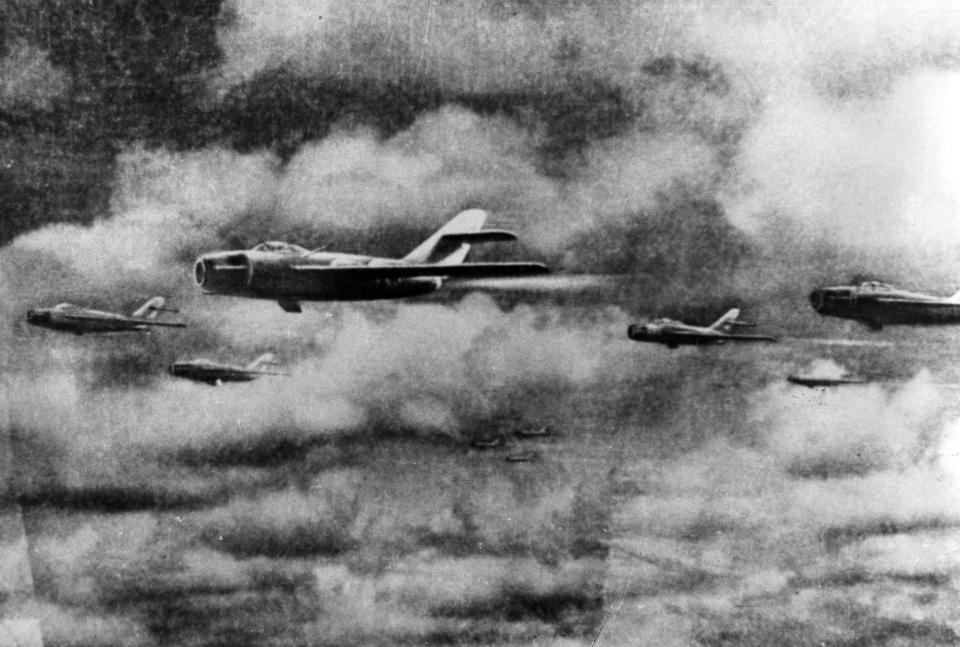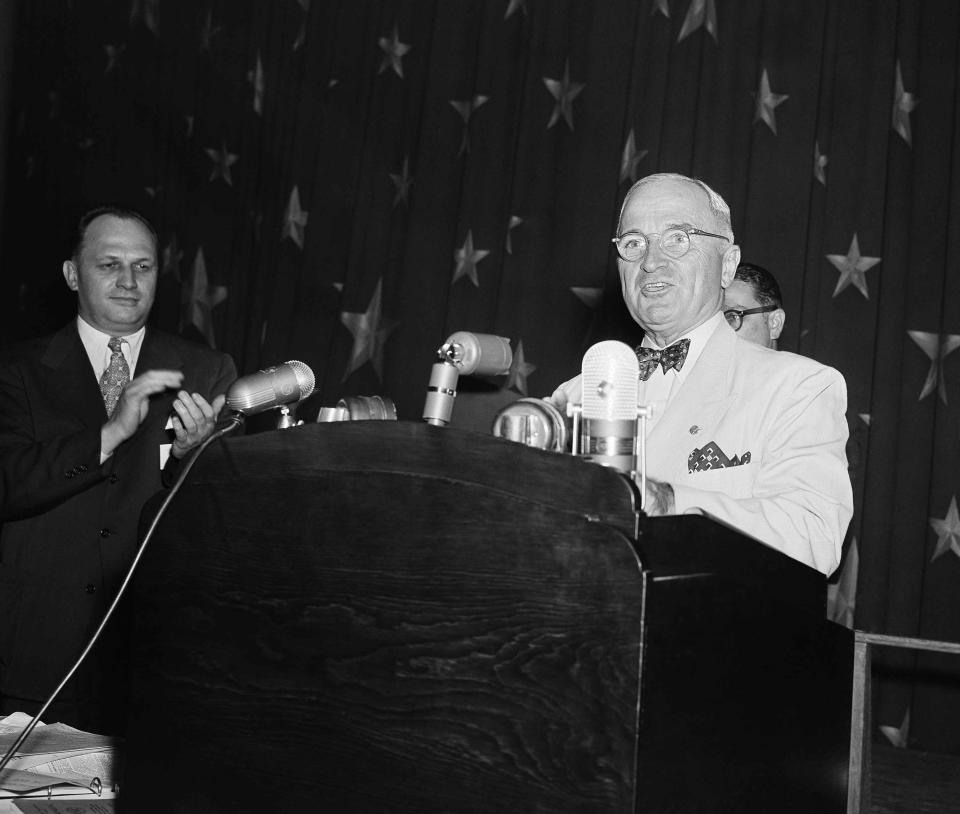In Korea crisis, history is a useful — and sobering — guide

President Harry S. Truman was on vacation on the evening of June 24, 1950 — the last time war erupted on the Korean Peninsula. The president had flown home to Independence, Mo., hoping to spend a relaxing weekend with his family. After dinner, the Trumans retired to the screened-in back porch, where they gossiped “about everything and nothing in particular,” Truman’s daughter, Margaret, later recalled. When the weather turned cold, they took the party inside, congregating in the library. But only a few minutes later the phone rang, and Truman withdrew to take the call. When he reappeared, he was wearing a “grim look,” Margaret remembered. “That was [Secretary of State] Dean Acheson,” Truman told the group. “The communists have invaded South Korea.”
Although the CIA had warned of a possible invasion, the timing was a surprise. Nearly all the major powers would have preferred to avoid a conflict. Americans, drained in the wake of the Second World War, longed for normal lives — to “go to the movies and drink Coke,” as one U.S. diplomat put it. Truman and Acheson, months before, had seemed to publicly signal that they were unlikely to defend South Korea in the event of an attack. Even North Korean leader Kim Il Sung’s allies, Soviet Premier Josef Stalin and China’s Mao Zedong, were lukewarm about the prospect of renewed fighting. Mao, newly victorious in the Chinese civil war, wanted to first firm up his revolution at home. Stalin, for his part, had acquiesced in the invasion, but warned Kim, “If you should get kicked in the teeth, I shall not lift a finger.”

Nearly seven decades later — as a rogue member of the Kim dynasty once again threatens to upset the regional power balance — it is worth recalling the lessons of the last time North Korea and the United States stumbled into war. As in 1950, none of the big powers — frankly, nobody in their right mind — is eager for a renewed conflict on the Korean Peninsula. Still, the events of that fateful June remain a cautionary tale — a warning that, if nothing else, it only takes one really determined actor to spark a crisis.
Today, once again, the North Korean leader is virtually alone in his belligerence. Although China has no desire to see a nation on its border collapse, both Beijing and Moscow signed on to the most recent package of U.N. sanctions, even as they succeeded in watering them down. President Trump has threatened Pyongyang with “fire and fury” if Kim remains recalcitrant, but even the most hawkish among the president’s inner circle recognize the perils of using force. “Until somebody solves the part of the equation that shows me that 10 million people in Seoul don’t die in the first 30 minutes from conventional weapons,” Trump’s former adviser Stephen Bannon told an interviewer last month, “I don’t know what you’re talking about; there’s no military solution here. They got us.”
And yet, the possibility, however remote, exists that war may be exactly what Kim Jong Un is angling for. Although simple survival seems the more likely explanation for Kim’s nuclear provocations — especially given the North’s relative weakness — his family has always viewed the Korean War as an unfinished revolution. Some North Korea watchers have warned that Kim’s dash to build a nuclear arsenal capable of striking the United States could be designed to prevent Washington from intervening in the event of a renewed thrust south across the 38th Parallel. “If the Americans face a choice between San Francisco and Seoul,” one analyst recently told the New York Times, “they will choose San Francisco.”

To be sure, the world is a far different place than it was in 1950. The Cold War is over; the modern-day tensions between Washington, Beijing and Moscow owe far more to power politics than to ideology. Nor did Kim Il Sung’s invasion then have anything to do with nuclear ambition — although the Soviet Union had just detonated its first atomic bomb the year before, touching off the atomic arms race between Washington and Moscow. Nevertheless, today’s policymakers would do well to take a closer look at some of the common themes.
One is that it is impossible to disentangle North Korea policy from China policy. The relationship between the two neighboring nations is profoundly symbiotic. Since its dynastic days, China has viewed shoring up peripheral regions like Southeast Asia, Tibet, Xinjiang, and Korea as a national-security imperative. And if China watches Korea closely, the reverse is also true. Mao’s victory in 1949 in the Chinese civil war inspired Kim Il Sung to attempt to unite the Korean Peninsula with a revolution of his own. Today, too, an increasingly assertive Beijing is only likely to embolden Pyongyang.

At the same time, the history of the Korean War teaches us to maintain a healthy humility about our ability to divine Beijing’s intentions. There is no guarantee that China can be cajoled into aligning its North Korea policy with Washington’s — even as part of a larger bargain, as some thinkers like Henry Kissinger have suggested. In the year leading up to the Korean War, American intelligence was so poor that it routinely — and falsely — reported that Mao was gravely ill, or even dead. (He lived for another quarter-century.) Although today U.S. intelligence is far more formidable, the tea leaves in Beijing —and in Pyongyang, for that matter — remain largely inscrutable.
A final lesson is that American politics can dramatically alter Washington’s response to the Kim family’s provocations. American foreign policy underwent a sea change over the course of the year leading up to the last Korean War — partly the result of a more nationalistic strain of domestic politics. For years, Democrats like Franklin D. Roosevelt and Truman had hoped that China and the Soviet Union might cooperate with the U.S. in establishing a postwar order in East Asia. But by 1949, against a backdrop of Red-baiting at home and rising tensions in Europe, hawks in Truman’s Cabinet were pushing him to do far more to challenge communist aggression in Asia. Today, again, Trump’s own ultranationalism — not to mention his desire to distract attention from his domestic woes — makes confrontation that much more likely.

Trump signaled as much in his remarks in the Rose Garden last summer, when he declared, “The era of strategic patience with the North Korean regime has failed. … Frankly, that patience is over.” As far back as April, Vice President Mike Pence said exactly the same thing during a visit to South Korea. Yet gritty persistence — not wishful thinking or rash provocation — is exactly what the problem demands.
Foreign policy crises are not like headaches, Dean Acheson once observed — you can’t just “take a powder and they are gone.” Rather, he added, they “are like the pain of earning a living. They will stay with us until death.”
The North Korean standoff may well be resolved in our lifetimes — but it is unlikely to happen quickly. “The mills of the gods grind slowly, especially in Asia,” the columnist Walter Lippmann wrote in the months leading up to the outbreak of the Korean War. Today, almost seven decades later — and after millions of deaths on the peninsula — the problem persists. There is no guarantee that absorbing the lessons of the last war will help prevent the outbreak of a new one. But they can at least keep us from being caught by surprise.
Read more from Yahoo News:



